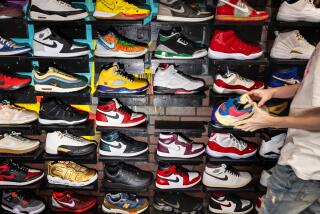Treading Carefully
The catalog alone could squash a small dog.
Bicycling shoes. Volleyball shoes. Shoes for urban warriors. Skateboard shoes. Cheerleading shoes. Shoes for sporty newborns.
Nike’s Fall ’96 catalog--it’s a workout just to lift it--is crammed with so many styles of athletic shoes, you can’t help but wonder: Does the world really need 412 different ways to dress its sweaty feet?
Manufacturers apparently think so. The athletic shoe scene has come a long way since the days when kids begged their moms for P F Flyers, sneakers that enabled a generation of future baby boomers to “run faster, jump higher!”
Today, athletic shoes constitute a $11-billion industry, and range is all the rage. Manufacturers offer everything from hiking boots with retractable spikes (makes for a smooth glacier-to-sidewalk transition) to “21st century moccasins” (Nike’s Air Moc) to soccer shoes with removable studs (designed, says maker Diadora, by “experts in foot morphology”).
If the variety seems confusing, the manufacturers’ shoe-speak is downright dizzying: Did you want Trinomic cushioning or HydroFlow? Hexalight or InstaPump? Say, how ‘bout some Exoskeletal stripes with that DuoSole?
It’s enough to make neophytes scramble for their bunny slippers. What’s a consumer to do? A dozen experts--from shoe-shop owners to salespeople to trade group analysts--offer their suggestions.
* First, understand basic athletic shoe anatomy: The upper covers the top part of the foot. The insole, or sock liner, provides arch support and some cushioning. The midsole is where the bulk of cushioning takes place. The outsole, the part that strikes the ground, provides traction and durability.
Being able to identify and understand the purpose of these features will enable you to better navigate the hype and high-tech mumbo jumbo. Only then can you choose a shoe that’s right for you--one that supports, cushions and fits properly.
* Be realistic about your needs. Before you shell out big bucks for “high-tech” shoes--Nike’s new Air Max is priced at $140--it’s wise to ask: Are you really going to train for the New York City Marathon? Or do you just want to be a hit at dress-down day at the office?
A survey by Footwear Market Insights of Nashville, Tenn., revealed that Americans paid an average of $32.53 for their athletic shoes in 1995, though experts say you should expect to pay at least $50 for a quality shoe that lasts.
* Seek quality advice. If you’re new to the shoe-buying scene, find someone experienced in your sport to offer general guidance (take care that they’re not sponsored by a shoe company). A longtime coach or athlete can usually offer impartial insights into what particular features to look for; he or she might even have a favorite (read: reputable) salesperson to recommend.
Be wary, though, if your advisor insists that one brand or one style is the best. The perfect shoe for one person can be a podiatric nightmare for another.
* Don’t rush. While the experienced athlete may be able to enter a store, choose a shoe and walk out with a purchase in a matter of minutes, the rookie shopper needs time. Expect to spend at least 30 minutes, and try out at least three pairs. (Bring your own socks so you can better judge the shoe’s fit.) Many shoe stores will let you jog around the floor, through the stock room, even down the block to get a feel for the shoes. Take 50 laps around the store if you need to. Make it your day’s workout.
* When buying new shoes, bring in your old pair. An old pair of shoes is like a character sketch, one that an experienced salesperson should be able to read accurately. Does your foot roll outward when you run or inward? Do you land on the ball of your foot or your heel? By scrutinizing the shoes, many telltale clues are revealed to determine what kind of shoe is best for you.
(Hint: If you hand your old shoes to a salesperson and he says, “Ugh, why’d ya bring those stink bombs in?” find yourself another store.)
* Buy cross-trainers . . . for your next cruise. Sure, says Terry Burke of Chick’s Sporting Goods in Tustin, cross-trainers “are fine for a light workout in the gym--or for walking around Disneyland.” But if you’re seriously considering using them for two sports as different as tennis and running, forget it. Here’s why:
Sports like tennis, volleyball and basketball require the foot to move in all directions--forward, backward and laterally. Shoes for those sports are designed to encourage those motions. In running, shoes are designed to restrict all but forward motion. Put the two designs together and you have a shoe that isn’t particularly effective at either.
* Be wary of the flash. Shoe manufacturers are coming out with everything from running shoes with iridescent soles to basketball shoes decorated with bull’s-eye patterns, many with premium price tags. Remember, though, that eye-catching doesn’t necessarily translate to performance-enhancing. Not unless looking good motivates you to work out.
Says Craig Chambers, co-owner of the Encino running store Phidippides: “People tend to base their decisions on aesthetics.”
* Lastly, remember: Shoes can only do so much.
A few years back, a pair of Tarahumara Indians from Mexico’s Copper Canyon area took on the infamous Leadville 100, a brutal 100-mile trail race through the Colorado Rockies. While other runners ran the race in shoes costing $100 or more, the Tarahumaras finished first and second overall . . . wearing thin leather sandals.
Air Tarahumara?






